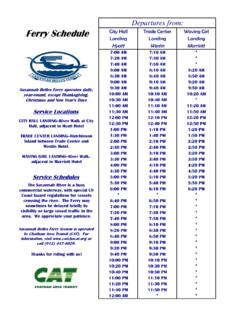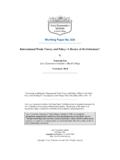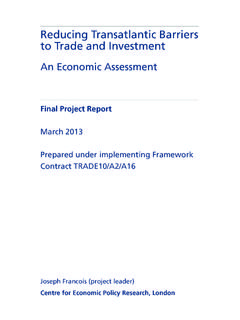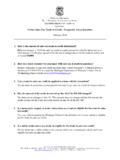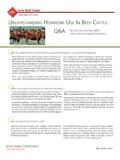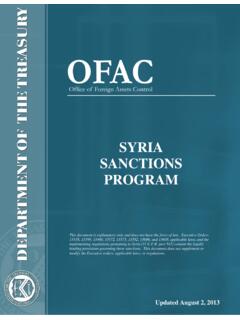Transcription of ECONOMIC - World Bank
1 World BANK MIDDLE EAST AND NORTH AFRICA REGIONINTEGRATION IN THE GCCWORLD BANK MIDDLE EAST AND NORTH AFRICA REGIONE conomic Integration in the GCCECONOMICE conomic Integration in the GCCO ffice of the Chief EconomistMiddle East and North Africa RegionThe World BankWORLD BANK MIDDLE EAST AND NORTH AFRICA REGION OCTOBER 2010 2010 The International bank of Reconstruction and Development/The World Bank1818H Street, NWWashington DC 20433 Telephone: 202 473 1000 Internet rights volume is a product of the Social and ECONOMIC Development Group of the Middle East and North Africa Region of the World Bank. The findings, interpretations, and conclusions expressed herein are those of the author (s) and do not necessarily reflect the views of the Board of Executive Directors of the World Bank or the govern-ments they represent. The World Bank does not guarantee the accuracy of the data included in this work.
2 The boundaries, colors, de-nominations, and other information shown on any map in this work do not imply any judgment on the part of the World Bank concerning the legal status of any territory or the endorsement or acceptance of such and PermissionsThe material in this work is copyrighted. Copying and/or transmitting portions or all of this work without permis-sion may be a violation of applicable law. The World Bank encourages dissemination of its work and will normally grant permission permission to photocopy or reprint any part of this work, please send a request with complete information to the Copyright Clearance Center, Inc, 222 Rosewood Drive, Danvers, MA 09123, USA, telephone 978 750 8400, fax 978 750 4470, other queries on rights and licenses, including subsidiary rights, should be addressed to the Office of the Publisher, World Bank, 1818H Street, NW, Washington, DC 20433, USA, fax 202 522 2422, e-mail photograph: World Bank/Dominic FREE PUBLICATIONC ontentsAcknowledgements ivForeword vAcronyms and Abbreviations viiExecutive Summary 11.
3 Introduction 2 Main Characteristics of the Gulf Economies 2 The Gulf Cooperation Council 42. Integration through Commodity and Services Trade 8 Commodity Trade 8 Services Trade 93. Financial and Monetary Integration 124. Integration through Infrastructure 155. Global Integration Trends 17 External Trade Policies 17 Collective Trade Agreements 18 Integration with the Arab World 19 Membership in WTO 19 Relations with the European Union 206. Issues and Challenges to Further Integration 21 Conclusion 24 References 26 TablesTable 1 Trade Indicators in GCC Countries 3 Table 2 Logistics Performance Index, 2010 4 Table 3 GCC Tariff Rates and Exemptions, 2010 (%) 7 Table 4 Trade Policy Ranking, 2005 10 Table 5 Status of GCC Regional Trade Agreements 19ivFiguresFigure 1 Rankings on the Ease of Doing Business 3 Figure 2 Logistics Performance Index 3 Figure 3 Concentration and Diversification Indices of Export Products in MENA 5 Figure 4 Growth of GCC Intraregional Trade 9 Figure 5 Destination of GCC Non-oil Trade 9 Figure 6 Services Trade Restrictiveness Indices (STRI) 11 Figure 7 Trade Tariff Restrictiveness Index (average MFN applied tariff)
4 18 Figure 8 Applied Tariff Rates for GCC Countries 18 AnnexesAnnex 1 Trade Agreements in the MENA Region 27 Annex 2 Statistical Tables 28 AcknowledgementsThis report was prepared by a team consisting of Mustapha Rouis (TaskTeam Leader), Ali Al-Abdulrazzaq and Kevin Carey under the guidance of Farrukh Iqbal, Acting Chief Economist, and Shamshad Akhtar, Vice President, Middle East and North Af-rica Region. The authors are grateful to Jean-Pierre Chauffour and Bernard M. Hoek-man from the World Bank for their comments on earlier versions. Isabelle Chaal Dabi and Liliane Vert ( World Bank) provided valuable administrative assistance and Amanda Green (Consultant) edited the the Middle East and North Africa (MENA) region has weath-ered the recent global financial and ECONOMIC crisis relatively well, it still faces daunting medium-term challenges. These include high unemployment (especially among young people), vulnerability to oil and food price shocks and water scarcity and inefficiencies of public sectors.
5 Integration of the region into the global economy has been slow. Of particular concern is the stagnation in the region s share of global non-oil exports, an indication of missed opportunities for di-versification and growth. Integration within the region, while rising, is also on the low side when compared with other middle- and high-income regional blocs. Over the last year or so, there has been an increasing momentum on the part of the region and the World Bank Group to focus on a set of initiatives to promote more cooperation within the region. These initiatives include a host of analyt-ical pieces to examine the current state of regional collaborative arrangements with emphasis on assessing and explor-ing ways of fostering greater trade inte-gration, labor mobility and migration prospects, prospects for energy integra-tion and resource sharing and infrastruc-ture development to reduce nontariff barriers.
6 The region has been able to make some inroads, albeit at different degrees in each of the geographical groupings, to support the integration of the Arab World into the global economy. To start off the removal of intra-regional tariffs under the Pan-Arab Free Trade Area (PAFTA) and the adoption of low common tariffs by the Gulf Cooperation Council (GCC) which coupled with improvements in infrastructure, especially roads and tele-communications is generating benefits. But much remains to be done, espe-cially in reducing nontariff barriers to trade, harmonizing policies and proce-dures, and facilitating cross-border trade through development of infrastructure links and trade facilitation. Fortunately, trade in services has recently emerged on the agenda of national and regional authorities this is an area of substantial potential welfare gain for the the problems, the World Bank has been working closely with the MENA region to develop and imple-ment regional activities investment projects, institution-building, harmoni-zation of policies and procedures that are likely to enhance ECONOMIC growth FOREWORD viand address common challenges across the re-gion.
7 As part of this endeavor, the Office of the Chief Economist, MENA Region, has pre-pared a series of reports to assess the achieve-ments of the region with respect to integration. The first report, 2008 ECONOMIC Developments and Prospects, looks at the role of integration in global competitiveness for the region as a whole and special reports have been pre-pared to take stock of the regional cooperative frameworks, their issues and prospects. These reports examine ECONOMIC integration among three sub-regions: the Gulf countries (Bahrain, Kuwait, Oman, Qatar, Saudi Arabia, and the United Arab Emirates), the Maghreb (Algeria, Libya, Mauritania, Morocco, and Tunisia), and the Mashreq (Iraq, Jordan, Lebanon, Syria, and West Bank and Gaza). Egypt is sometimes classified in the literature as a Mashreq coun-try though with ties with North Africa given its AkhtarVice PresidentMiddle East and North Africa RegionThe World BankviiAcronyms and AbbreviationsASEAN Association of Southeast Asian NationsAWI Arab World InitiativeCU Customs UnionEMU European Monetary UnionEU European UnionFATS Foreign Affiliates Trade in ServicesFDI Foreign direct investmentFTA Free Trade AgreementGATS General Agreement on Trade in ServicesGAFTA Greater Arab Free Trade AreaGCAC GCC Commercial Arbitration CentreGCC Gulf Cooperation CouncilGDP Gross domestic productGIC Gulf Investment CorporationIMF International Monetary FundLPI Logistic Performance IndexMENA Middle East and North AfricaMERCOSUR Mercado Com n Sur (Argentina, Brazil, and Uruguay)
8 MFN Most Favored NationNAFTA North American Free Trade AgreementNTBs Non-Trade BarriersPAFTA Pan-Arab Free Trade AreaRTA Regional Trade AgreementSEA Single European ActTIFA Trade and Investment Framework AgreementTTRI Tariff-only Trade Restrictiveness IndexUAE United Arab EmiratesUEA United ECONOMIC AgreementUNCTAD United Nations Conference on Trade and DevelopmentVAT Value-Added TaxWB World BankWTO World Trade Organization1 Executive SummaryThis study discusses the status of ECONOMIC integration of the six Gulf Cooperation Council (GCC) countries among themselves, with the larg-er Middle East and North Africa (MENA) region and globally. It also as-sesses the main challenges to further integration. The GCC is the most advanced example of subregional integration in the MENA region, and its objectives are among the most ambitious in the developing World . It has evolved well beyond a focus on free trade in goods to embrace high levels of cross-national labor and capital mobility, and the progressive opening of many sectors within each economy to all member GCC is much more integrated with the rest of the World than with MENA because of the role of oil and gas in trade patterns.
9 But integration via labor markets is sig-nificant in MENA, especially for Mashreq countries and Egypt. Foreign direct invest-ment (FDI) linkages from the GCC to the rest of MENA are also important. Never-theless, because GCC integration occurs against the backdrop of fairly similar cir-cumstances in the member countries, the mechanisms and drivers of integration are somewhat different than in other regional blocs, where membership is more following are among key characteris-tics of integration among the GCC states. First, GCC countries are all highly depen-dent on hydrocarbons, which remain a core prerogative of national not regional policy. Second, sovereignty is still shared cautiously, so supranational institutions are being built up slowly; key decisions emerge from opaque intergovernmental processes rather than from empowered regional institutions. Third, public sec-tors in each country are closely linked to the sharing of benefits from hydrocarbon wealth among nationals.
10 This complicates the political economy of ECONOMIC reform strategies such as privatization and subsidy reduction, which in turn limits the scope for regional integration in areas where the public sector is dominant. Fourth, GCC countries compete with each other in sec-tors that might otherwise offer scope for regional initiatives, such as finance, trans-port, and downstream ongoing integration mechanisms, particularly in infrastructure, addressing common challenges should impart fur-ther momentum to the GCC. These in-clude: labor market strategy, where there is scope to revisit the open immigration policy at the regional level; the financial sector, given the regional spillovers from country-level debt distress episodes; fiscal policy, given the countries objective of diversifying revenue sources; and service sector liberalization, which would expand the size of markets and promote the effi-cient allocation of resources for the GCC as a whole.










